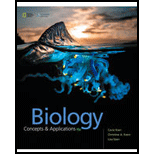
Concept explainers
What atom has only one proton?
| a. hydrogen | c. a free radical |
| b. an isotope | d. a radioisotope |
Introduction:
An atom is defined as the smallest unit of a substance. Atoms contain protons, electrons, and neutrons. Elements are pure substances that are composed of atoms. Molecules are formed by the interaction of atoms with the help of a chemical bond.
Answer to Problem 1SA
Correct answer:
The hydrogen atom has only one proton. Hence, the correct answer is option a.
Explanation of Solution
Reason for correct answer:
Option a. is given as “hydrogen.”
Atoms are defined as the basic units of matter. An atom is composed of a central core called nucleus. Protons are the positively charged particles in an atom that occupy the nucleus; neutrons are the uncharged particles present in the nucleus; and electrons are the negatively charged particles that move around the nucleus. An element is defined as a substance that is made up of one type of atoms. Hydrogen is the simplest element as its atom has a nucleus consisting of one proton.
Reason for incorrect answer:
Option b. is given as, “an isotope.”
Isotopes refer to the variants of the same element that contain the same number of protons, but different number of neutrons. However, hydrogen is the simplest element that contains one proton. This indicates that the isotopes of different elements have a different number of protons. Hence, option b. is incorrect.
Option c. is given as, “a free radical.”
Atoms that contain unpaired electrons are known as free radicals. Free radicals are highly unstable. They may force electrons upon other atoms or drag electrons away from them. This property makes them dangerous. This indicates that free radicals do not contain proton. Hence, option c. is incorrect.
Option d. is given as, “a radioisotope.”
Radioisotopes are the isotopes containing unstable nucleus that emits radiation on decay. During the decay of carbon 14, one neutron splits into a proton and an electron. The electron is emitted as radiations. This indicates that the radioisotopes of different elements contain different number of protons. Hence, option d. is incorrect.
Hence, the options b., c., and d. are incorrect.
Hydrogen is the simplest element that contains only one proton in the nucleus. Thus, the correct answer is option a.
Want to see more full solutions like this?
Chapter 2 Solutions
BIOLOGY:CONCEPTS+APPL.(LOOSELEAF)
- Which phrase best describes what a functional group does? a. assembles large organic compounds b. influences the behavior of organic compounds c. splits molecules into two or more parts d. speeds up metabolic reactionsarrow_forwardWhat is an alloy? A. A compound of two metals B. An element of two metals C. A mixture of two metals D. A molecule of two metalsarrow_forwardWhich element is a metal? A. C B. Rn C. CI D. Crarrow_forward
- Which bond in a polypeptide backbone does not freely rotate? a. The bond between CO and NH b. The bond between C-alpha and NH c. The bond between C-alpha and CO d. The bond between C-alpha and C-beta c. d.arrow_forwardThe element phosphorus is needed in organisms to builda. proteins.b. carbohydrates.c. ATP.d. steroidsarrow_forwardWhich statement is true of all atoms that are anions?(A) The atom has more electrons than protons.(B) The atom has more protons than electrons.(C) The atom has fewer protons than does a neutral atomof the same element.(D) The atom has more neutrons than protons.arrow_forward
- The atomic number gives thea. number of neutrons in the nucleus.b. number of protons in the nucleus.c. weight of the atom.d. number of protons in the valence shell.arrow_forwardWhich one is NOT TRUE for ice floating on water? a. The density of ice is less than water. b. Hydrogen bonds are ordered. c. It has less stable hydrogen bonds. d. Life is impossible below ice in Antarctica.arrow_forwardChoose the combination of answers that most accurately completes the statement.Ionizing radiation removes from atoms. a. protons c. electrons b. waves d. ionsarrow_forward
- Which statement is false? A. Elements are found in compounds and molecules B. compounds are made of elements C. a molecule must be made of at least two atoms D. chemical bonds form between molecules of solute and solvent E. two atoms of oxygen make a molecule of oxygenarrow_forwardWhich class of biological molecules has the most diverse functions, including transport, structure, signaling, and motility? a) proteins b) nucleic acids c) lipids d) carbohydratesarrow_forwardWhat is the pH of a solution that has a higher concentration of H+ ions than water? A. > 7 B. 7 C.< 7arrow_forward

 Human Biology (MindTap Course List)BiologyISBN:9781305112100Author:Cecie Starr, Beverly McMillanPublisher:Cengage Learning
Human Biology (MindTap Course List)BiologyISBN:9781305112100Author:Cecie Starr, Beverly McMillanPublisher:Cengage Learning



